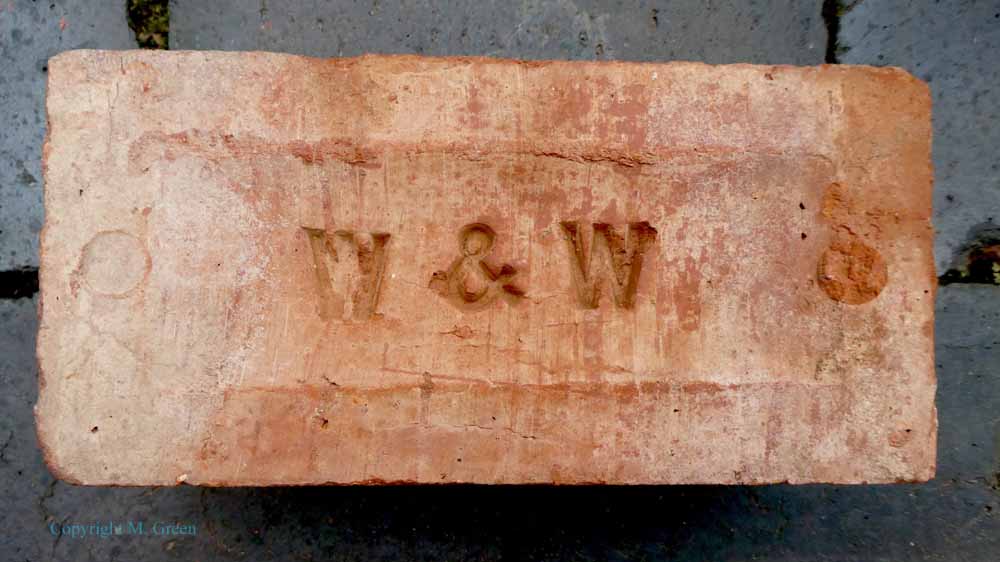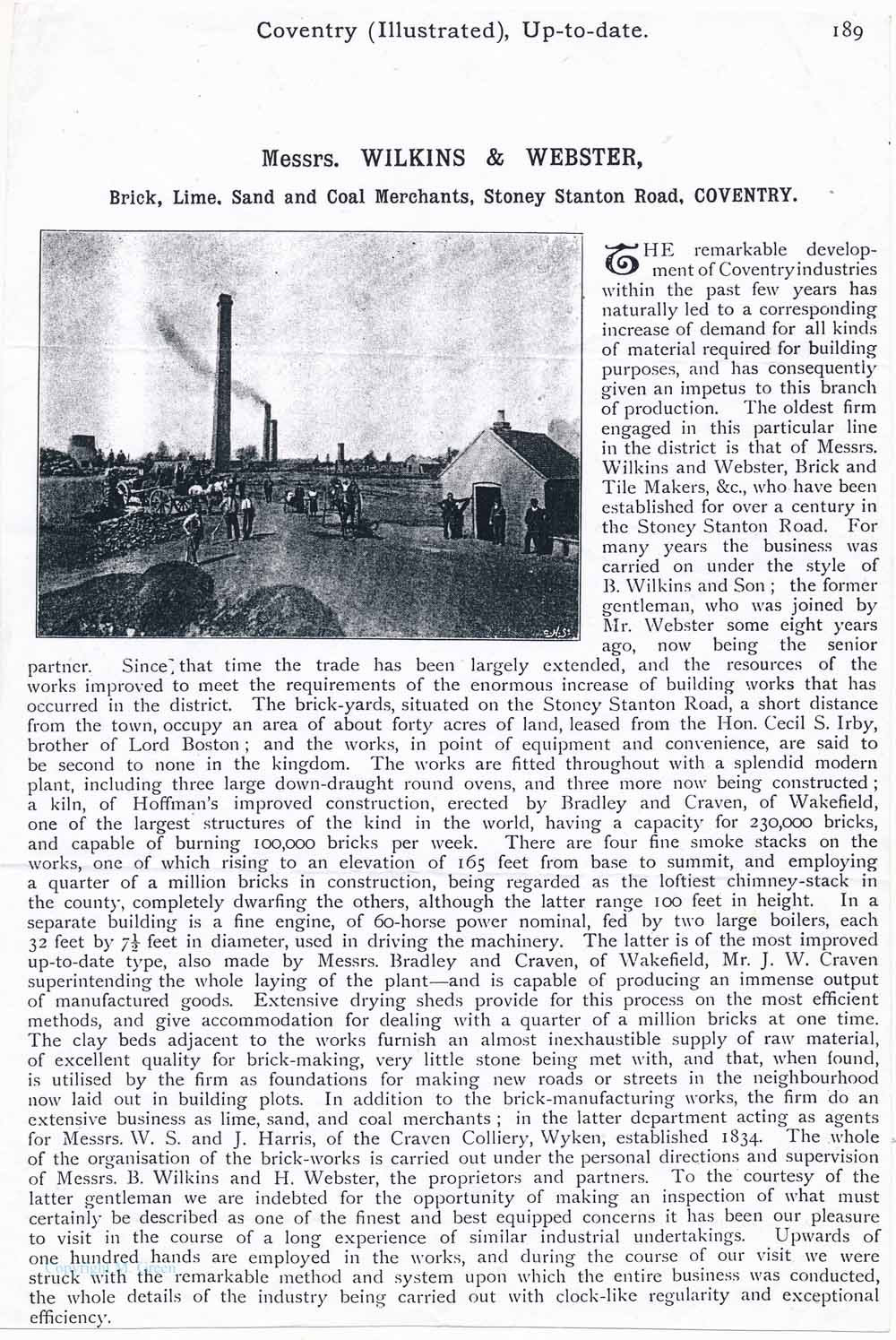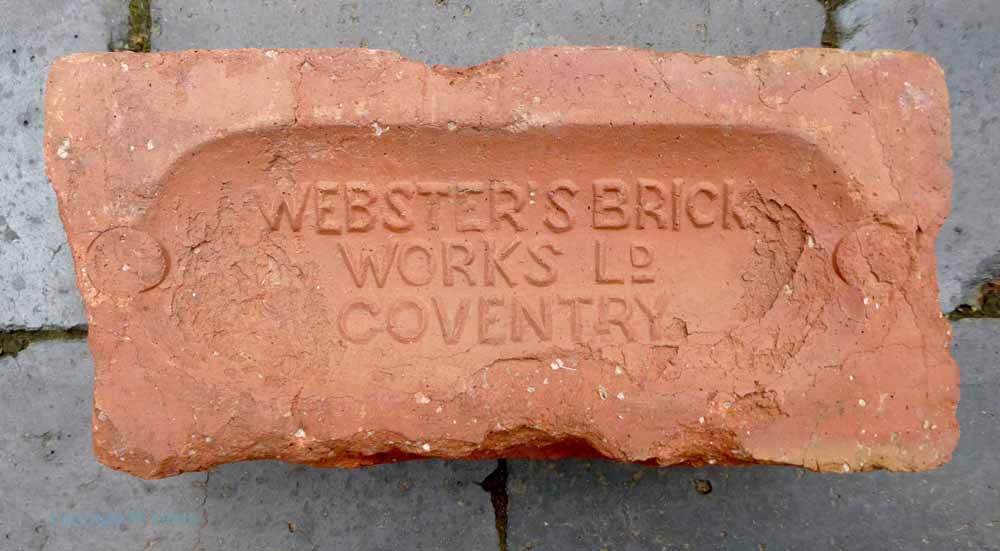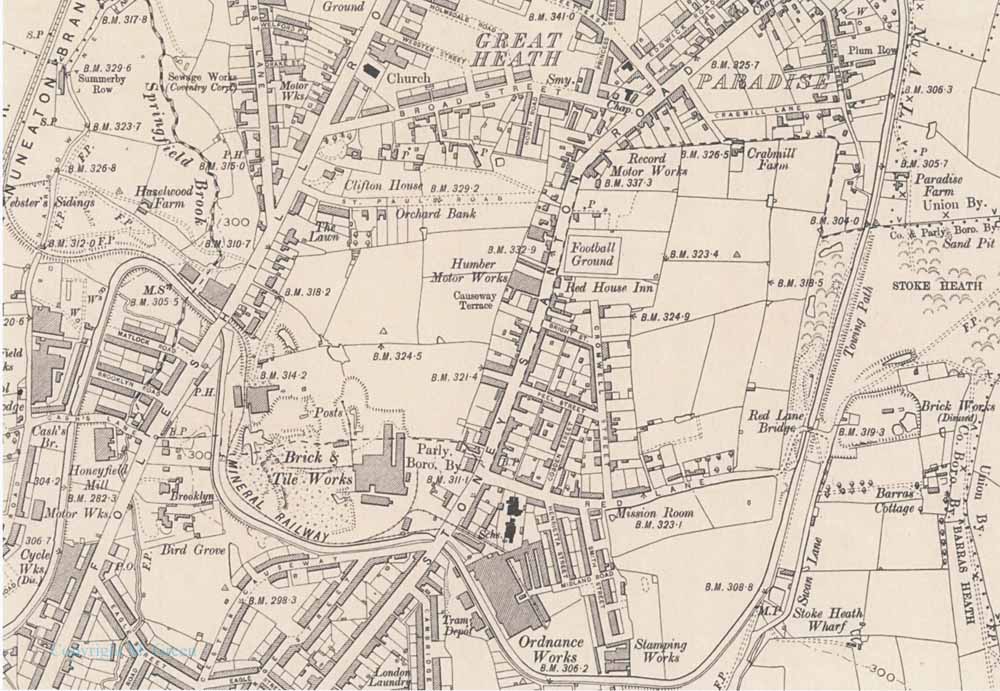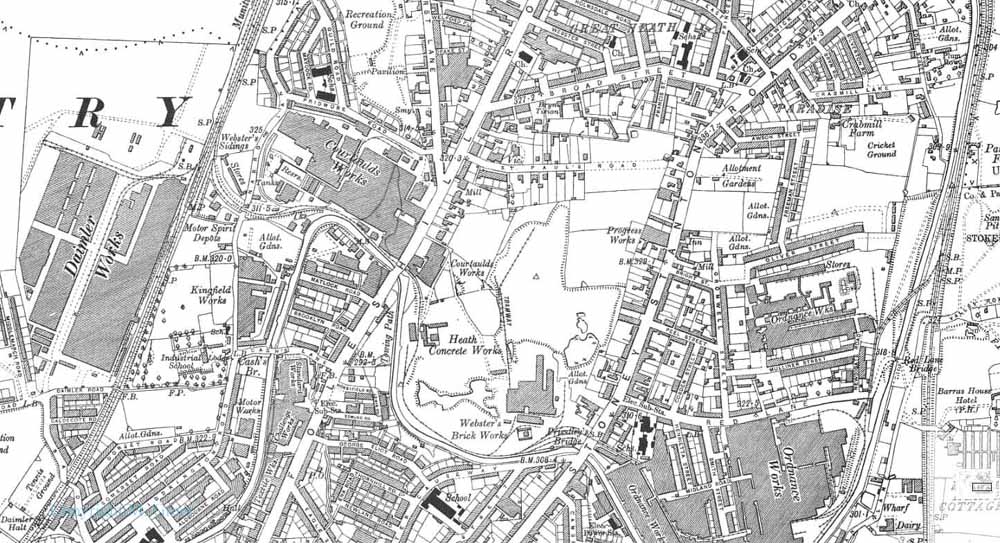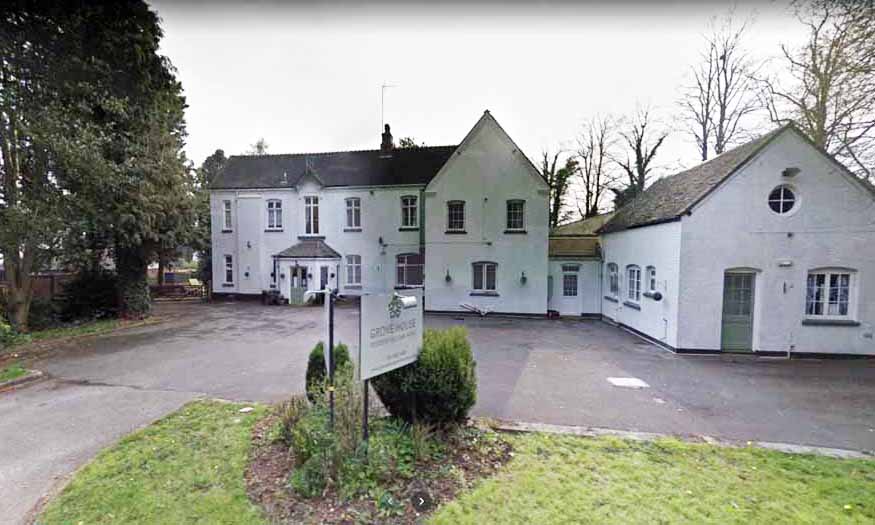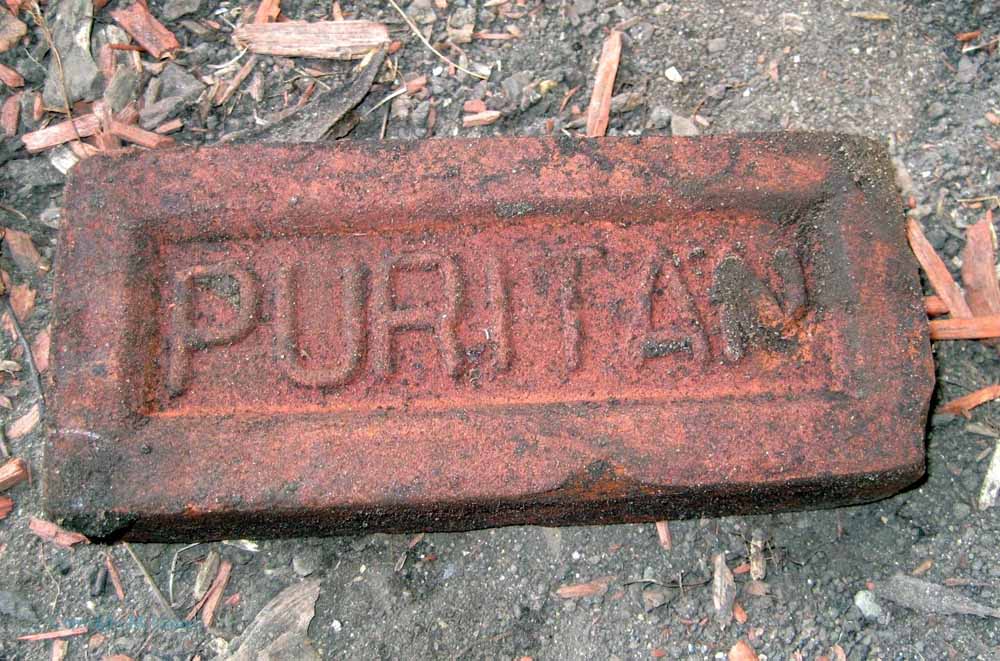One Brick: Several Stories
WILKINS, WEBSTERS, HEMMING, MIDLAND BRICK
Part 2: HENRY WEBSTER: ‘Little Harry Webster: ever the cheery optimist’
The story of Wilkins & Webster, brickmakers, is a venture that brings together two Coventry families. The Wilkins family had long been brickmakers and builders in Coventry, and whilst father Thomas and brother Joseph set up business together (see Part 1), Benjamin branched out on his own.
By 1851 Benjamin had moved from the family home to New Road (off the Foleshill Road), a street that seemed to be full of ribbon weavers. Indeed his wife, Hannah, was listed as one such weaver. He also brought his two sons William and Thomas into the business under the title of ‘Wilkins & Sons’
Benjamin Wilkins is recorded as journeyman bricklayer in the 1851 census, and he began to be recorded in the Trade Directories. Morris’s Commercial Directory of Warwickshire with Birmingham in 1866 recorded ‘Wilkins, Benjamin, bricklayer, Brick-kiln Lane (now Broad Street), Foleshill. From 1872 he is listed in Kelly’s Directories as bricklayer in the Stoney Stanton Road. He continued to be listed as bricklayer not brickmaker until the 1881 Census, and he also emphasised the production of lime.
A series of editions of the Coventry Herald in 1881 carried the following advert:
Midland Lime Works, Stoney Stanton Road, Coventry
ANY QUANTITY OF LIME ALWAYS IN STOCK
From 500 to 1,000 Quarters, supplied at 3 days’ notice
B.WILKINS & SONS, Proprietors
Benjamin Wilkins was certainly operating the brick works on the Stoney Stanton Road in the 1870s (confirmed by Trade Directories), but the partnerships with his sons are dissolved, firstly losing William in 1876 (by mutual consent) and then Thomas in 1888 (by mutual consent), on the occasion of joining forces with Henry Webster.
Henry Webster was a Foleshill man, educated at the old Church School in the company of workers’ champion Tom Mann, and started work as a butcher at 142 Foleshill Road. He married Lucy Ann Wilkins in 1878 at St. Laurence, Foleshill. Lucy Ann was the daughter of Benjamin Wilkins. The Wilkins-Webster connection was made.
In fact Henry is listed in the 1891 Census as ‘master butcher and brick manufacturer’ (a rare combination, indeed!), still living on the Stoney Stanton Road.
An example of their advertising at this time read:
MIDLAND BRICK, TILE and LIME WORKS, STONEY STANTON-ROAD, COVENTRY
WILKINS and WEBSTER Proprietors
Manufacturers of all kinds of Moulded Bricks, Terra-Cotta, Agricultural Drain Pipes,
Roofing Tiles, etc. Dealers in all kinds of Building Materials
Large Stocks always on hand. Coal and Sand Merchants
Agents for W. and J. Harris, Craven Colliery, Coventry
The connections to Craven Colliery are frequently made in company advertising:
“COALS, hand picked, delivered to any part of town, direct from Craven Colliery
WILKINS & WEBSTER, Midland Brickworks, Stoney Stanton Road, Coventry”
(Coventry Evening Telegraph 18 December 1895)
The story of Craven Colliery – and other collieries nearby – is covered in the excellent publication by Mike Kinder ‘The Victoria, Wyken, Alexandra and Craven Collieries’. This is one of a number of publications on local collieries by Mike Kinder and Peter Lee, published by the Nuneaton Local History Group www.nuneatonhistory.com
There are also plenty of examples of the use of Wilkins and Webster bricks in the construction of local buildings e.g. The Board School, Red Lane. Experiments with new products continued as well. At the June 1898 annual meeting of the company Henry Webster announced that he was continuing with his experiments to produce glazed tiles, and similar articles which had a market the world over (Coventry Evening Telegraph 10 June 1898). In fact, in subsequent years, the firm worked hard at diversifying from the production of common bricks, and developing the quality and range of its products e.g. moulded bricks, quarries, chimney pots and ridge tiles.
The following is a description of the works in 1896 from Coventry (Illustrated) Up-to-date Views and Reviews (Robinson, Son & Co.). It reminds us of the fact that the land utilised for clay extraction and brick production was leased from Hon. Cecil S. Irby.
The partnership, in fact, does not last long and Webster takes over the business in 1896.
July 1896 Coventry Herald:
NOTICE IS HEREBY GIVEN, THAT the PARTNERSHIP heretofore subsisting between us, the undersigned, BENJAMIN WILKINS and HENRY WEBSTER, carrying on business as Brick and Tile Manufacturers, at the Midland Brick and Lime Works, Stoney Stanton road, Coventry, in the County of Warwick, under the style or firm of “Wilkins and Webster”, has been DISSOLVED by mutual consent, and from the 18th day of July, 1896. All Debts due and owing by the said late Firm will be received and paid by the said Henry Webster, who will carry on the said business at the same address as heretofore. Dated this 30th day of July, 1896. BENJAMIN WILKINS. HENRY WEBSTER.
Webster’s brickworks soon became a limited company, with Henry Webster as one of its directors. Major developments took place at the site.
The Coventry Evening Telegraph of 11th. June 1897 reported:
‘Large extensions are being made by the Midland Brick and Lime Co. to their brickmaking factory in Stoney Stanton Road. The company, besides large and handsome offices, are having built two very large German kilns. The accepted tender for the new offices was that of Mr. C. Garlick, jun., who is also erecting two tall smoke stacks for the same company.’
One of the most interesting developments at this time was the promotion and construction of the Websters Brickworks Railway. The company’s horizons were clearly broadening and they began to look at supplying markets beyond Coventry and the local area, and concluded that a link to the railway would be an essential ingredient in achieving this. At the 1899 Shareholders Annual Meeting, it was stated:
‘Shareholders are today in possession of some of the largest and best-equipped brickworks in the district, and your directors are unanimously of opinion that the time has now come for the Company to cease to be dependent on Coventry, and to lay itself out for a share of the ever-increasing demand in the London and Birmingham markets …With this in view, it is proposed to connect the works with the railway.’
(Coventry Evening Telegraph 22nd. August 1899)
At the same time, they acquired the brickworks of C. Gray Hill (see elsewhere on the WIAS website) which adjoined the Websters site and also fronted the proposed line of the railway. In the process, they also arranged with the landlord, the Hon. Cecil S. Irby, for an extension of the lease from thirty to fifty years.
A separate company was formed for the railway:
‘Webster’s Brickworks Railway Company has been registered with a capital of £10,000, in £5 shares, to acquire, complete, maintain and work a railway recently constructed, and in course of construction, leading from a point near Coventry, on the Coventry and Nuneaton branch of the London and North-Western Railway, to point in or near Stoney Stanton Road, Coventry, with the site thereof, and all or any of the erections and works in connection therewith, and to carry on the business of railway proprietors, locomotive and rolling stock builders, carriers, warehousemen, dock-owners, etc’.
21 Dec. 1901 The Birmingham Daily Gazette
WEBSTER’S BRICKWORKS COMPANY
‘The fifth ordinary general meeting of Webster’s Brickworks Limited were held yesterday at the works, Coventry. Mr. Frederick Warwick (chairman), presiding. The report set forth that the profit on the year’s working amounted to £82.17s.4d, but after allowing for renewals, depreciation, debenture interest etc. there was as adverse balance of £2855.4s.1d. The Chairman, in moving the adoption of the report stated that the directors had done everything they could to ensure the success of the business, and he thought the results of the steps which had been taken indicated a better outlook. Of course, the brick trade was one that depended very much on the conditions of things generally in the locality, and as the cycle trade, on which Coventry so largely depended was depressed, building had suffered too. But he thought there was every indication that things had reached their worst in the city, and that soon this company would begin to feel the effects of renewed activity in the cycle industry. He mentioned the fact that Mulliner’s had purchased the factory of the old ‘Cycle Manufacturers Tube Company’, opposite Webster’ brickworks), and as the firm was going to employ 1000 hands, the erection of the houses necessary for so many hands must make a material difference in the brick business. The branch line made by Websters Brickworks Railway Company Limited was now earning enough to pay a dividend to its shareholders, and negotiations were practically complete for an extension of the railway into the Mulliner’s factory (the Ordnance Works).’
In as series of Annual Reports in the early years of the twentieth century, the business experience of Websters can be traced, with the clear correlation between demand for bricks and the state of the local and national economy. Activity in brickmaking is seen as an indicator of economic conditions – a build up of stocks indicating a slowing down in construction and economic activity in general; a reduction in stock levels suggesting expanding demand. Apart from fluctuations in demand, the Company suffered some of the common problems experienced by many brickmakers over the years, fortunately on a very occasional basis – accidents and fatalities; employment disputes and a strike; fire damage.
Henry Webster at some stage before the First World War distanced himself from the company (did he jump or was he pushed?) and turned to pastures new.
The railway proved to be a success, with trade in coal an important component of that prosperity. Opened in 1901, the line was soon extended in to serve the Courtaulds factory. A link to the Coventry Loop Line was established in 1914, and the line was an important route for heavy Ordnance traffic during the First World War. Courtaulds eventually took over the railway. Information on the Mineral Railway -later the Foleshill Railway – can be found on the Warwickshire Railways website. www.warwickshirerailways.com
Henry Webster in later life
This description of the brickmaking activities of Henry Webster does not do justice to a man of many talents. “Little Harry Webster” was described as “a cheery optimist throughout his life” in the obituary in The Coventry Herald of March 11th. 1927. He clearly never lost his love of his original trade as a butcher, returning to it in later years. He then went on to wok as a refreshment-house keeper in Jordan Well. His obituary also mentioned that he had interests in stamping and cycle-making activities. This could easily have been nearby Smiths Stamping Works.
He participated for a short time in local government, moving on from membership of the School Board in Foleshill, to serve briefly as a local councillor.
According to his obituary, at the height of his business success he was able live “at a large house on the main highway to Keresley, near to Corley”. Thanks to assistance from David Fry, this has been identified as Grove House, Tamworth Road, now a care home. It is just up the road from Keresley Hall, the family home of motor magnate William Hillman, (now converted as the Royal Court Hotel). This indicates there was clearly money in making bricks as well as manufacturing Hillman cars! Leafy Coundon obviously proved attractive to Coventry’s successful industrialists.
Courtesy of David Fry:
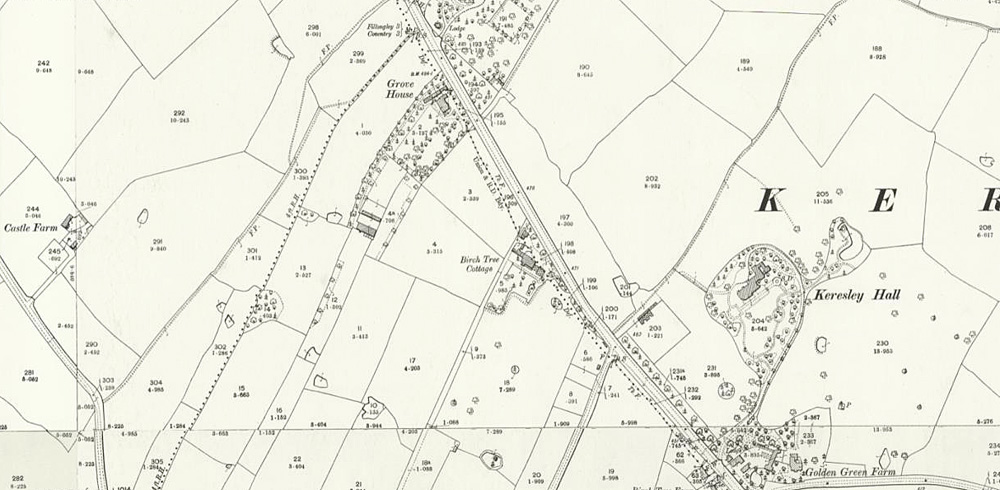
The 1900 Warwickshire Kelly’s shows Harry Webster living at Grove House in Coundon on what is known today as the Tamworth Road. It still exists as a care home (see top photograph below) – a sizeable house but not quite in the same league as the Hillman home, Keresley Hall/Royal Court Hotel (bottom photograph).
At some stage close to the start of the First World War Henry Webster decided to emigrate to the United States. The obituary wrote “he even tried his fortunes in one of the Middle States of America after the First World War”, before returning to Coventry for the final years of his life. It turns out that he in fact went to Hamden, Ohio, and, very helpfully, Henry Webster wrote a letter to the Coventry Standard published on December 1st. 1916, recalling his life in Coventry and relating some of his new experiences. Webster’s letter contained much patriotic fervour which reads as politically incorrect to modern eyes, but it is repeated here nevertheless, justified by his links to the Ordnance Works.
‘After speaking of the part he played in building Webster’s railway from Foleshill to the brickworks depot on the Stoney Stanton Road, and in introducing both Courtaulds and the Ordnance Works to Coventry (quite a claim!), he writes:
“I am proud to live and see that the Ordnance Works is a national concern, and gives old Coventry a world-wide reputation as being one of the principal centres that are making guns and ammunition to crush the Huns. Mr. Mulliner (Herbert Hall Mulliner, Managing Director of the Ordnance Works) – prophetic and far-seeing man that he was – used to say to me ‘Ah, Webster, they wont believe what I saw, but from what I have seen and what has come to my knowledge in Germany I am certain there will be war before long, and before this country is ready for it, and I shall relax none of my efforts and exertions to bring the Ordnance Works to the highest possible pitch of efficiency and production’ How true his words have turned out to be!”.
Mulliner has, of course, been accused of exaggerating the German threat and their build-up of naval power, stoking up demand for military expenditure by the UK government from which he would directly benefit.
Meanwhile, over in the United States, Henry Webster had become the manager of the local brick-making company, Puritan, which had been formed in 1909. Just to prove that brick collecting and interest in the derelict sites of old brickworks is not confined to a corner of Warwickshire, I include this example from Hamden, Ohio, USA, together with a youTube video describing what remains of the works!
The Websters name continued as brickmakers in Coventry, even though Henry was not involved, with a new era developing after 1938 when the business was taken by David Hemming. This is covered in Part 3 of the story.
Copyright © Martin Green 2020


